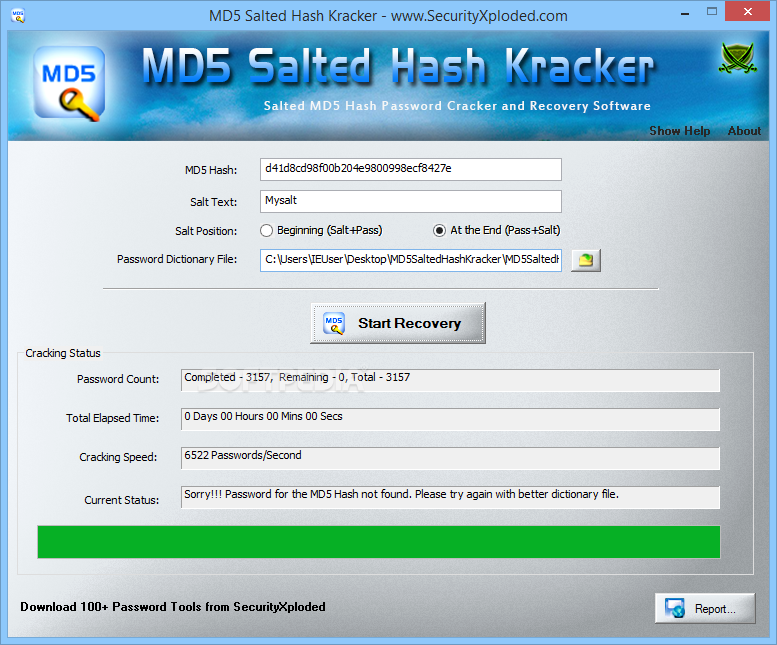
- UFD2 HASH DECRYPTER FREE DATABASE PASSWORD
- UFD2 HASH DECRYPTER FREE DATABASE CRACK
- UFD2 HASH DECRYPTER FREE DATABASE WINDOWS
UFD2 HASH DECRYPTER FREE DATABASE WINDOWS
They are, of course, not stored in clear text but rather in “ hashed” form and for all recent Windows versions, using the NTLM proprietary (but known) hashing algorithm. Physically they can be found on places like C:WindowsSystem32config in files like ‘SAM’ and ‘SYSTEM’.
UFD2 HASH DECRYPTER FREE DATABASE PASSWORD
Password are stored on hard drives in something called “Registry Files”. And that'll be even harder if you add uppercase and some numbers such as Hiimjohnandiwasbornin1980 for instance. For instance illrememberthispasswordthatsforsure, will be really hard to break through bruteforce and rainbow tables. Or for instance hash the salt before you concatenate it, everything is good to complexify your password before storing it.īy the way, if you're looking for a good way to remember very hard-to-break passwords, as a user, you could use sentences instead of a word. You could also be creative and split the salt in two, then add a part at the beginning of the password and the other part at the end.

Please note that it is preferable to use random generated strings as salt, if you just use the same string for each password it will be far too easy to break. That would make the password look like a~/!c^12/* (password, which is obviously really harder to crack. Then before storing this password in your database, you just concatenate a random string (generated with a php function for instance) such as a~/!c^12/* ( for example. It will be obviously really easy to break. For instance, say we are using the password 'password' (good idea). A salt is simply a caracters string that you add to an user password to make it less breakable.
UFD2 HASH DECRYPTER FREE DATABASE CRACK
If you still want to use md5 to store passwords on your website, good thing would be to use a 'salt' to make the hash more difficult to crack via bruteforce and rainbow tables. It is now better to use hash functions such as Sha256, 512, bcrypt, scrypt, whirlpool for instance. If you are interested into md5 collisions and want to know more, you can check this link. It is now possible to find a md5 collision in a few minutes. Since that date, collisions became easier and easier due to the increasing calculation power. In 2004, chinese scientists found a complete collision on md5. Md5 is no longer considered as a secure way to store passwords. I then sorted them, and enlarge the final wordlist by creating a script that multiplicated the list to finally lend to a unique and pertinent wordlist. Our decrypter database is coming from all the wordlist I was able to find on the internet.

If you are building a new website, Sha-256, 512, or other kinds of encryption (with salt) would be better than md5, or even sha-1. One should know that md5, although it's very used and common, shouldn't be use to encrypt critical data, since it's not secure anymore (collisions were found, and decrypt is becoming more and more easy).

Here we have a 10.000.000.000+ md5 hash database to help you with decryption. The only way to decrypt your hash is to compare it with a database using our online decrypter. This function is irreversible, you can't obtain the plaintext only from the hash. Md5 ( Message Digest 5) is a cryptographic function that allows you to make a 128-bits (32 caracters) 'hash' from any string taken as input, no matter the length (up to 2^64 bits). Our tool uses a huge database in order to have the best chance possible to trace the decrypted text. This algorithm is not reversible, ie it is normally impossible to find the original word from the md5 hash. It's like having your own massive hash-cracking cluster - but with immediate results! MD5 means a 128-bit encryption algorithm, generating a 32-character hexadecimal hash. This allows you to input an MD5, SHA-1, Vbulletin, Invision Power Board, MyBB, Bcrypt, Wordpress, SHA-256, SHA-512, MYSQL5 etc hash and search for its corresponding plaintext ('found') in our database of already-cracked hashes. In cryptography, SHA-1 (Secure Hash Algorithm 1) is a cryptographic hash function which takes an input and produces a 160-bit (20-byte) hash value known as a message digest – typically rendered as a hexadecimal number, 40 digits long.


 0 kommentar(er)
0 kommentar(er)
